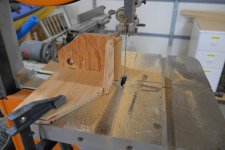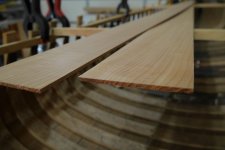While I've been working on removing the fiberglass and paint from the Old Town restoration project I described here earlier in the year, my mind has turned to fabricating replacement planking for the canoe. I'm curious if any of you are interested in describing, or even posting a few photos of the process of making planking for a cedar canvas canoe.
Of course I built a cedar strip canoe last winter and learned all the steps to make strips and do the bead and cove, scarfing and milling gunwales, but making planking 3-3/4" wide and 5/32" thick is a big step for me. I have done every search I can think of online and come up with nothing. This would be a good contribution to the DIY restoration community too. I believe I have the right tools for the job, a decent bandsaw and a good thickness planer. That being said, I'm starting with 7/8" cedar boards and think I should be able to get 3 planks out of each one. Does that sounds right? How do you set up your woodworking tools to make planking?
Thanks, Mark
Of course I built a cedar strip canoe last winter and learned all the steps to make strips and do the bead and cove, scarfing and milling gunwales, but making planking 3-3/4" wide and 5/32" thick is a big step for me. I have done every search I can think of online and come up with nothing. This would be a good contribution to the DIY restoration community too. I believe I have the right tools for the job, a decent bandsaw and a good thickness planer. That being said, I'm starting with 7/8" cedar boards and think I should be able to get 3 planks out of each one. Does that sounds right? How do you set up your woodworking tools to make planking?
Thanks, Mark


